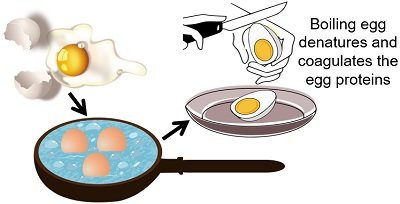Determination of effect of temperature on coagulation of egg protein

The coagulation of egg proteins is a process that involves the denaturation and aggregation of proteins in eggs, leading to the formation of a solid mass. Temperature is a crucial factor in this process, as it directly influences the kinetic energy of molecules and, consequently, the rate and extent of protein denaturation and coagulation.
Here's how you can determine the effect of temperature on the coagulation of egg proteins:
Experimental Setup:
Materials:
- Fresh eggs
- Thermometer
- Water bath or hot plate
- Containers for heating
- Stirring rod
- Timer
- pH meter (optional)
Procedure:
Egg Preparation:
- Crack the eggs and separate the egg whites from the yolks.
- Weigh or measure the egg whites to ensure consistency in the amount of protein used for each experiment.
Temperature Ranges:
- Choose a range of temperatures for your experiment. For example, you might want to test at room temperature, body temperature (37°C), and higher temperatures.
Heating Process:
- Divide the measured egg whites into separate containers.
- Heat each container to the desired temperature using a water bath or hot plate.
- Stir the egg whites gently to ensure uniform heating.
Observations:
- Observe changes in the egg whites as they are heated.
- Note the temperature at which coagulation begins, progresses, and is complete.
- Record the time taken for coagulation at each temperature.
pH Measurement (Optional):
- Measure the pH of the egg whites at different temperatures. Changes in pH can influence protein coagulation.
Data Analysis:
- Plot a graph of temperature vs. time for coagulation. This will help visualize the effect of temperature on the coagulation process.
- Analyze the data to identify trends and patterns.
Egg Preparation:
- Crack the eggs and separate the egg whites from the yolks.
- Weigh or measure the egg whites to ensure consistency in the amount of protein used for each experiment.
Temperature Ranges:
- Choose a range of temperatures for your experiment. For example, you might want to test at room temperature, body temperature (37°C), and higher temperatures.
Heating Process:
- Divide the measured egg whites into separate containers.
- Heat each container to the desired temperature using a water bath or hot plate.
- Stir the egg whites gently to ensure uniform heating.
Observations:
- Observe changes in the egg whites as they are heated.
- Note the temperature at which coagulation begins, progresses, and is complete.
- Record the time taken for coagulation at each temperature.
pH Measurement (Optional):
- Measure the pH of the egg whites at different temperatures. Changes in pH can influence protein coagulation.
Data Analysis:
- Plot a graph of temperature vs. time for coagulation. This will help visualize the effect of temperature on the coagulation process.
- Analyze the data to identify trends and patterns.
Considerations:
Control Experiment: Perform a control experiment at room temperature to compare against the heated samples.
pH Control: If you choose to measure pH, ensure that the pH of the egg whites is consistent across different temperatures.
Repeat Experiments: Conduct multiple trials at each temperature to ensure reproducibility.
Safety Precautions: Follow safety guidelines when working with heat sources.
Control Experiment: Perform a control experiment at room temperature to compare against the heated samples.
pH Control: If you choose to measure pH, ensure that the pH of the egg whites is consistent across different temperatures.
Repeat Experiments: Conduct multiple trials at each temperature to ensure reproducibility.
Safety Precautions: Follow safety guidelines when working with heat sources.
Expected Results:
- You should observe that as temperature increases, the coagulation process occurs more rapidly.
- At higher temperatures, you may see denaturation happening quickly, leading to a faster coagulation.
This experiment helps demonstrate the impact of temperature on the coagulation of egg proteins and provides insights into the kinetics of the process.
Comments
Post a Comment